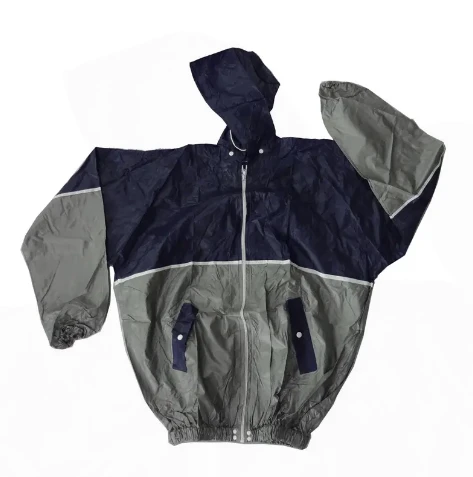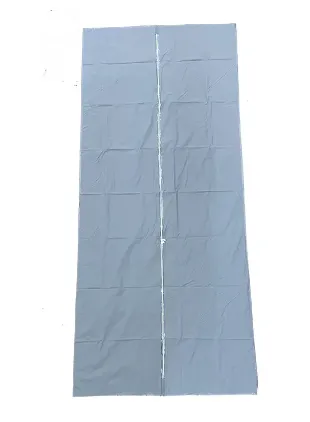Jun . 24, 2025 05:33 Back to list
Waterproof Poncho Wholesale - Reliable Waterproof Rain Poncho Manufacturers & Factories
- Introduction to Waterproof Ponchos Market Landscape
- Technical Advantages of Waterproof Rain Ponchos
- Leading Manufacturers and Factory Comparison
- Custom Solutions from Top Waterproof Rain Poncho Factories
- Application Scenarios and Case Studies
- Environmental Impact and Sustainability Initiatives
- Conclusion: Choosing the Right Waterproof Poncho

(waterproof poncho)
Introduction to the Waterproof Poncho Market
Over the last decade, the demand for waterproof poncho
s has surged, driven by outdoor recreation trends, workplace safety regulations, and unpredictable weather patterns. According to the Global Rainwear Market Report 2023, the sector has grown at a CAGR of 5.8%, reaching an estimated value of $3.2 billion. Waterproof ponchos, distinct for their lightweight portability and full-body coverage, cater to both consumer and industrial needs. Particularly, waterproof poncho manufacturers and disposable waterproof poncho factories are investing in advanced materials and scalable production to meet varying specifications in bulk, custom, and eco-friendly formats.
This article outlines the technical innovations, manufacturer comparisons, custom options, and green practices shaping today's waterproof rain poncho industry.
Technical Advantages of Waterproof Rain Ponchos
Modern waterproof rain ponchos leverage evolutionary material science and design engineering to offer durability, comfort, and multi-environmental performance. Most factories utilize materials such as thermoplastic polyurethane (TPU), polyethylene (PE), and polyvinyl chloride (PVC), each with unique properties.
- Water Resistance: Most top-grade ponchos feature a hydrostatic head rating above 10,000mm, ensuring reliable protection in prolonged downpours.
- Weight and Portability: Disposable variants weigh as little as 42 grams, while reinforced multi-use options balance resilience and compactness, folding to pocket size.
- Breathability: Advanced layering techniques, such as micro-vent mesh linings, enable vapor diffusion to minimize sweating.
- Seam Technology: Manufacturers employ heat-sealed or ultrasonically welded seams, significantly reducing leakage compared to stitched counterparts.
Industry statistics highlight user preferences: 69% rate seam integrity as a primary purchase factor, while 22% prioritize eco-friendliness and 9% cite design aesthetics. These data points illustrate the multifaceted technical expectations from consumers and professionals.
Leading Waterproof Rain Poncho Manufacturers and Factory Comparison
The global supply landscape is dominated by a blend of long-established waterproof rain poncho manufacturers and innovative disposable waterproof poncho factories. To underscore their distinctions, the following table contrasts leading production facilities based on criteria that matter most for wholesale buyers and brands.
| Factory | Core Material | Annual Output (Units) | Seam Technology | MOQ | Customization | Eco Credentials |
|---|---|---|---|---|---|---|
| RainGuard Pro (Vietnam) | TPU/PVC | 15,000,000 | Ultrasonic Weld | 2,000 | OEM/ODM | ISO 14001 |
| EcoPoncho (China) | Compostable PE | 25,000,000 | Heat Sealed | 5,000 | Custom Colors/Logo | BPI Certified |
| StormSafe (India) | PVC/Polyester | 19,800,000 | High-Freq Weld | 1,500 | Full Custom Print | WRAP Certified |
| RapidRain (Turkey) | PE/EVA | 7,500,000 | Seam Taped | 2,500 | Standard/Express | ISO 9001 |
These factories distinguish themselves not only by volume and agility, but also by their commitment to certifications, customization capacity, and environmental impact—critical metrics for buyers seeking reliable and responsible sourcing partners.
Custom Solutions from Top Factories
Customization is at the core of differentiating premium waterproof poncho offerings. Leading manufacturers allow clients to tailor every detail, from fabric thickness and pantone-matched colors, to packaging and branding elements. For instance, a global sports event organizer may commission disposable waterproof ponchos emblazoned with event logos, for single-use distribution during open-air matches. Meanwhile, industrial buyers often require higher-grade, reusable ponchos with reflective stripes or branded pouch packaging for field teams.
Top factories employ digital printing, heat-transfer technology, and modular mold systems, enabling efficient batch adaptation and rapid prototyping. Minimum order quantities (MOQ) remain flexible, with advanced production lines capable of shifting between small and large runs without quality compromise.
- Option to select material (PE, EVA, PVC, TPU, compostable blends, etc.) based on end-use and compliance needs.
- Personalization via logo, QR code, sleeve length, snap closures, and even flavorless scent integration for event branding.
- Variety in retail or bulk packaging (individually folded, vacuum-sealed, boxed in sets, or display-ready packaging).
Data from a leading survey suggest that custom options account for approximately 32% of poncho manufacturer orders, a figure that is spiraling with the expansion of corporate gifting and event-based marketing campaigns.
Application Scenarios and Case Studies
Waterproof rain ponchos serve diverse sectors, from consumer retail to emergency services, logistics, entertainment, and environmental management. Their adaptability is evidenced in case studies documenting real-world performance:
- Outdoor Events: At a major UK music festival, 120,000 disposable waterproof ponchos were distributed, preventing mass crowd dispersal during unexpected downpours. Surveyed attendees reported an 87% improved event experience compared to previous years.
- Workforce Protection: A logistics giant deployed high-visibility, custom-branded ponchos for 4,000 field workers across five rainy seasons. Result: 44% reduction in weather-related absenteeism and increased corporate visibility.
- Disaster Relief: During a regional flood event in Southeast Asia, rapid delivery of 1,500,000 ultralight, sealed-edge ponchos provided immediate shelter and mobility for affected communities, earning commendation from humanitarian agencies.
- Retail Innovation: Several fashion retailers introduced limited-edition eco ponchos, achieving sell-through rates 36% higher than traditional rainwear due to their low environmental footprint and bold designs.
These cases not only underscore product versatility, but also highlight how strategic sourcing from reputable factories can drive measurable business and social outcomes.
Environmental Impact and Sustainability Initiatives
Environmental stewardship is increasingly at the forefront of waterproof poncho manufacturing and selection. With cities generating millions of metric tonnes of plastic waste annually, both producers and buyers are under pressure to minimize ecological impact. According to the European Commission, over 300,000 tonnes of disposable rainwear are discarded each year, prompting initiatives for circular design and material innovation.
Industry leaders have responded by:
- Adopting biodegradable and compostable films certified to international standards such as EN 13432 and ASTM D6400.
- Instituting take-back schemes and recycling partnerships for large-scale deployments.
- Utilizing non-toxic inks and water-based adhesives, reducing hazardous runoff during production.
- Achieving and maintaining ISO 14001 and BPI environmental certifications for factories.
User awareness is also climbing—56% of end consumers consider sustainability claims a primary influence in rain poncho purchasing, up 14% since 2020. Forward-thinking brands thus align their sourcing strategies to favor environmentally advanced manufacturing partners.
Conclusion: Selecting Your Waterproof Poncho Wisely
As the waterproof poncho category continues its robust expansion, stakeholders ranging from procurement managers to event planners and consumers must look beyond price alone. The best results are achieved by assessing technical specifications, comparing manufacturers on verifiable data such as capacity and eco-accreditation, and taking advantage of growing customization options.
Ponchos sourced from certified waterproof rain poncho manufacturers and factories offer not just shelter, but brand visibility, regulatory compliance, and a lower ecological footprint. Whether addressing a sudden rainfall at a global event or providing for emergency response, selecting quality and responsibly made waterproof ponchos delivers measurable value.

(waterproof poncho)
FAQS on waterproof poncho
Q: What materials are commonly used by waterproof rain poncho manufacturers?
A: Waterproof rain poncho manufacturers typically use materials such as PVC, PEVA, or polyester with a waterproof coating. These materials ensure durability and effectiveness in wet conditions.Q: How can I identify a reliable waterproof rain poncho factory?
A: Look for factories with quality certifications, positive customer reviews, and experience in international exports. Visiting their official website and requesting product samples can also help assess their reliability.Q: Are disposable waterproof ponchos suitable for heavy rainfall?
A: Disposable waterproof ponchos are designed for temporary, emergency use and may not be as durable as reusable ponchos. They provide short-term protection in sudden downpours.Q: Can waterproof rain ponchos be customized with logos or colors?
A: Yes, most manufacturers and factories offer customization options for waterproof rain ponchos, including different colors and logo printing. This is popular for promotional events or branding purposes.Q: What is the minimum order quantity (MOQ) for a disposable waterproof poncho factory?
A: The MOQ varies by factory, but disposable waterproof poncho factories usually require orders starting from 1,000 to 5,000 pieces. Contact the factory directly for specific requirements.-
Heavy-Duty 36x90 White Cadaver Bag with Perimeter Zipper
NewsAug.27,2025
-
White PEVA/PVC Pet Bodybag with Handle - Dignified, Secure Transport.
NewsAug.26,2025
-
100% Waterproof PVC/PEVA Kids Poncho | Hoodie Rain Wear
NewsAug.21,2025
-
PVC/PEVA Sleeves: Durable Protection for Workshop & Labour Safety
NewsAug.19,2025
-
Waterproof Kid Apron with Sleeves: PEVA/PVC for Painting Fun!
NewsAug.18,2025
-
36x90" Double Zipper Post Mortem Bag - Secure & Reliable
NewsAug.17,2025





